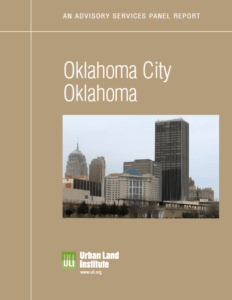Top Story
 Date: February 28 – March 5, 2010
Date: February 28 – March 5, 2010
Location: Oklahoma City, Oklahoma
Sponsor: Mayor Mick Cornett and the city of Oklahoma City
Chair: William H. Hudnut III
Subject Area: Economic Growth and Development
For the panel report, please visit ULI’s Knowledge Finder
A Plan with Solid Fundamentals
The magic of the Core to Shore Plan resides in its big ideas, whose strength is bolstered because they also express the plan’s solid fundamentals. Truly “Burnhamesque” plans take time: the realization of the Core to Shore vision will be measured in decades, not years. Five big ideas ground the plan, requiring constant vigilance over the long implementation time frame:
- Organizing the planning area around a central north–south axis, as represented by the Harvey “Spine” connecting the new Devon Tower to the Oklahoma River;
- Designating green and civic spaces including the Central Park, the Promenade Park, and the Oklahoma River waterfront;
- Boosting Oklahoma City’s reputation as a destination, as represented by the proposed convention center and associated hotels;
- Strengthening the city’s core by introducing a significant amount and a range of residential development; and
- Encouraging the economic development potential of the Oklahoma River in a way that integrates this amenity into the larger urban core.
The Core to Shore Plan’s long-term time frame requires flexibility. The city needs to be nimble enough to adapt as market conditions change and opportunities arise while staying committed to the Plan’s fundamental big ideas.
Getting the Details Right
The next step for the Core to Shore Plan is getting the details right. The vision is in place, but to fully realize the plan’s potential, several obstacles need to be overcome and several tools should be employed.
The relocated Interstate 40 will be a barrier to the north–south integration that is fundamental to the Core to Shore vision. Careful attention needs to be paid to how I-40 interacts with the surrounding land uses and to the design of circulation routes that cross it. Additional crossings, especially for pedestrians, may be necessary. The new “Boulevard” that replaces the existing I-40 may also be a barrier, unless it is designed as an exemplary arterial street with a total width of no more than 110 feet.
The convention center and associated hotels are prime means to realize the Core to Shore Plan. Great care needs to be taken in locating the convention center so that it simultaneously supports and takes advantage of the existing retail and entertainment development in and near Bricktown. The panel has significant concerns about the proposed location for the convention center along the east side of the Central Park. This location would be better served by residential development.
The plan’s relationship to the rest of downtown, especially Bricktown, needs to be considered so that the downtown districts reinforce each other without competing. Destination or lifestyle retail should be clustered in Bricktown, while retail development in the Core to Shore planning area should be on a smaller scale, focused on supporting the office uses in the central business district (CBD) and the planning area’s residential neighborhoods and parks. The bold vision in the Core to Shore Plan needs to be supported by more detailed planning efforts targeted to the following concepts and areas:
- An open-space framework, consisting of an integrated and hierarchical series of open spaces from the neighborhood level up to such regional attractions as the Central Park, supported by a streetscape master plan;
- A connectivity framework expressed through a downtown access and circulation master plan developed with the assistance of a new multimodal traffic model that is specific to the downtown area;
- An updated Strategic Action and Development Plan for the Oklahoma River that integrates the Core to Shore vision into the river development plan and aims to fully activate the river and capture its economic development potential; and
- Neighborhood plans for the residential areas, so that each of the four to six new or revitalized neighborhoods in the planning area has its own neighborhood plan that incorporates a range of housing types and price points, organizes the neighborhood around meaningful places, and includes supportive retail and community facilities.
The Panel’s Assignment
With much of the Core to Shore Plan’s public improvements started, the Executive Committee of the ULI Oklahoma District Council approached the city in 2009 with the desire to bring a ULI Advisory Panel to the city to address how to catalyze appropriate private development within the planning area.
In preparing for the panel, the city and ULI Oklahoma sought input from ULI members, the Greater Oklahoma City Chamber, and several community leaders to generate a list of over 60 questions related
to implementation of the Core to Shore Plan. Six priority questions were chosen:
- What are the most effective means of bringing about high-quality private development (especially residential and mixed-use) that is consistent with the public objectives of the Core to Shore Plan, in order to support and not compete with the momentum in other parts of downtown?
- What should the land uses be along the east and west sides of the park?
- In what sequence should we implement the major components of the Core to Shore Plan? How do we make mixed-use development work, especially along the Boulevard?
- How do we interface with the river to best activate it and make the most of that asset?
- Where should the Promenade Park be located?